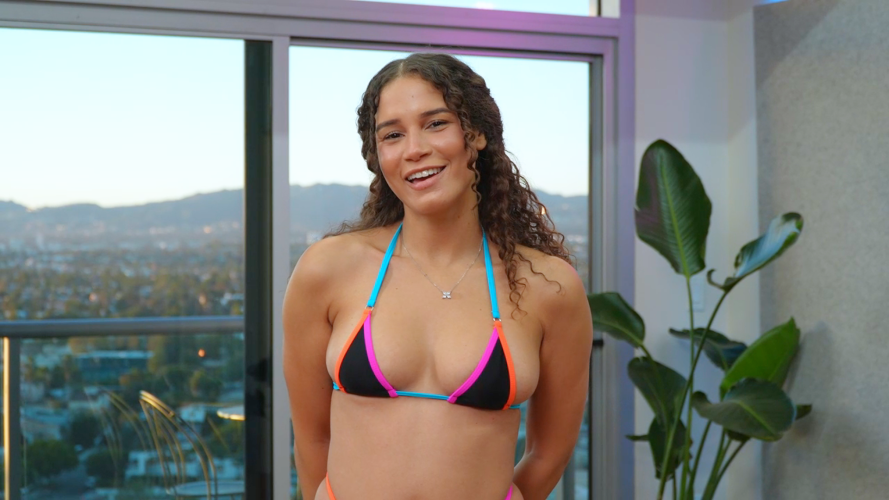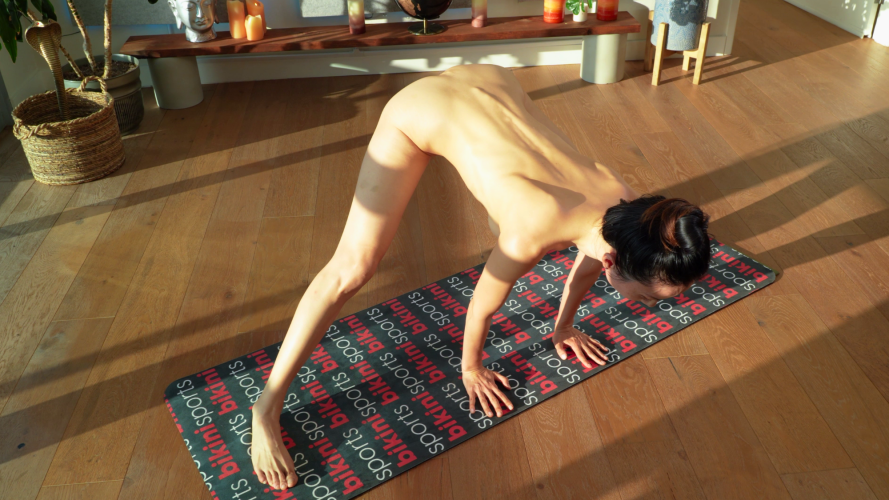22 May 2025
Yoga Poses, Naked Yoga
Nude Yoga: Complete Guide to Benefits, History & Practice (Stripped Down & Uncovered)

Nude Yoga: The Ultimate Guide to Stripping Down Your Practice
Nude yoga is raw freedom. Strip away the clothes and suddenly every stretch, every breath, every curve is on full display. What started thousands of years ago as a spiritual practice has become a modern movement — part fitness, part art, part rebellion against everything tight waistbands and spandex stand for. This guide breaks down the history, the benefits, and the best ways to experience nude yoga today, whether you're curious about your first at-home session or want to see how the pros do it on camera.
What is Nude Yoga (And Why Everyone's Talking About It)?
At its core, nude yoga strips practice down to its raw essentials—skin, breath, and movement. But the meaning goes deeper than just being naked on the mat.
In yoga philosophy, nudity symbolizes truth and freedom. It removes the layers of status and expectation that clothing often carries. In fitness, it means full range of motion and sharper body awareness. You see every muscle working, every line of alignment. In culture, it's become a way to challenge shame, embrace authenticity, and rediscover the body as something natural, powerful, and beautiful.
What used to be a fringe practice has now hit mainstream awareness. Studios from New York to Berlin host nude yoga classes, online communities share tutorials, and thousands of people are streaming nude yoga videos daily. Our complete nude yoga video library features 100+ classes taught by some of the most captivating instructors anywhere.
The History and Evolution of Nude Yoga
Ancient Origins: Where Nude Yoga Really Started
The practice of nude yoga, or "nagna yoga," has roots that stretch back thousands of years across multiple cultures and spiritual traditions. While modern nude yoga may seem like a recent trend, the historical record reveals a much deeper lineage.
Yogic Traditions in Ancient India
In ancient India, certain ascetic traditions practiced nude yoga in minimal or no clothing as a way to transcend worldly attachments and social conventions. The Naga Sadhus, holy men devoted to Lord Shiva, have practiced nude yoga and meditation for centuries as part of their spiritual discipline. For these practitioners, nudity represented a rejection of material possessions and societal constraints, allowing for complete devotion to spiritual practice.
The ancient text Javali Samhita, dating back to approximately 800 CE, contains references to nude yoga practices performed without clothing to achieve a state of "skyclad" or "digambara" (meaning "clothed in space" or "clothed in the directions"). These nude yoga practices were considered advanced techniques for transcending body consciousness and worldly shame.
Greek and Roman Influences on Nude Practice
In ancient Greece, physical training, including early forms of what we might recognize as nude yoga-like practices, was often performed in the nude. The word "gymnasium" derives from the Greek word "gymnos," meaning naked. Athletic training and philosophical education were intertwined in Greek culture, with nudity seen as natural and even noble in these contexts.
Roman bath culture also incorporated stretching and movement practices performed without clothing, focusing on the harmony between physical wellness and mental clarity —concepts that align closely with nude yoga principles.

Watch Indi's Exclusive Full Nude Yoga
Historical Evolution of Nude Yoga
Medieval Period and Underground Practice
During the medieval period, nude yoga practices became less common in mainstream society as religious conservatism spread across many cultures. However, certain tantric traditions continued to incorporate ritual nudity as a means of transcending dualistic thinking and embracing the wholeness of human experience.
The Nath yogis, founded by Gorakhnath around the 11th century CE, maintained some skyclad nude yoga practices within their more esoteric teachings, viewing the naked body as a perfect expression of divine creation rather than something to be hidden or ashamed of.
Colonial Influence and Suppression
The arrival of European colonial powers in India brought Western notions of modesty that significantly impacted traditional nude yoga practices. Many indigenous traditions, including those involving ritual nudity, were suppressed or driven underground during this period. This cultural clash resulted in a sanitization of yoga as it was presented to Western audiences in the early stages of its global spread.
Modern Revival of Nude Yoga
The modern revival of nude yoga can be traced to several key movements:
- Naturist Movement (Early 20th Century): The naturist philosophy, which emerged in Europe and spread to North America, emphasized the health benefits of nudity and outdoor living. Early naturist communities often incorporated nude yoga and other mindful movement practices.
- Counterculture Movement (1960s-1970s): The hippie movement embraced body freedom and challenged conventional attitudes about nudity. During this period, experimental yoga communities began reincorporating nudity into practice as a form of liberation and authentic expression.
- Body Positivity Movement (1990s-Present): As society began to challenge unrealistic body standards, nude yoga emerged as a powerful tool for developing body acceptance and appreciation for all body types.
- Digital Age Expansion (2000s-Present): The internet and social media have allowed nude yoga communities to connect globally, sharing knowledge and normalizing the practice beyond isolated communities.
Contemporary Nude Yoga Practice
Today's nude yoga landscape is diverse and evolving, encompassing various approaches:
Private Individual Practice: Many practitioners choose to practice nude yoga in the privacy of their homes, often as a personal ritual of self-acceptance.
Dedicated Studios: Specialized studios offering nude yoga classes have emerged in major cities worldwide, creating safe spaces for communal practice.
Retreats and Workshops: Immersive nude yoga experiences focusing on body freedom have become popular, often held in natural settings or dedicated retreat centers.
Online Communities: Virtual nude yoga classes and communities have made the practice accessible to those without local options, particularly accelerated by the global shift to online fitness during the COVID-19 pandemic.
Gender-Specific and Inclusive Spaces: The contemporary nude yoga scene includes classes specifically for women, men, or mixed-gender groups, as well as spaces explicitly welcoming to LGBTQ+ practitioners.
This rich historical context demonstrates that far from being a modern novelty, nude yoga represents a return to ancient wisdom traditions that recognized the profound connection between physical freedom and spiritual development. The practice has evolved through centuries of cultural change, emerging in its contemporary form as both a link to ancient traditions and a response to modern needs for authenticity and self-acceptance.
The Mind-Blowing Benefits of Nude Yoga Practice
The practice of nude yoga offers numerous benefits that extend beyond those of traditional clothed yoga. While some advantages are immediately apparent, others are supported by emerging research in psychology, physiology, and neuroscience. This section explores the evidence-based benefits of nude yoga across physical, psychological, and social dimensions.
Physical Benefits of Nude Yoga
Enhanced Body Awareness and Proprioception
Practicing nude yoga without clothing allows for a heightened awareness of the body's movements and positioning. Research in the field of proprioception (the sense of the body's position in space) suggests that direct skin contact with surfaces provides more accurate sensory feedback than when that contact is mediated by clothing.
A 2018 study published in the Journal of Bodywork and Movement Therapies found that participants reported increased sensory awareness during barefoot and minimally clothed movement practices compared to conventional exercise attire. This enhanced proprioception in nude yoga can lead to:
- More precise alignment in nude yoga poses
- Greater awareness of muscle engagement during nude yoga practice
- Improved balance and stability in nude yoga sequences
- Faster correction of improper form
As one nude yoga practitioner notes: "I can actually see my muscles working and feel exactly where I'm holding tension. It's like having a built-in feedback system that clothing would normally hide."
Unrestricted Movement in Nude Yoga
Clothing can restrict movement in certain poses, particularly those involving deep twists, binds, or extensive stretching. Nude yoga eliminates these restrictions, allowing for:
- Fuller range of motion in complex nude yoga poses
- More natural expansion during deep breathing
- Elimination of adjustments typically needed for clothing
- Freedom from distraction of readjusting clothing during nude yoga practice
Research on movement biomechanics confirms that even lightweight, stretchy clothing can create subtle restrictions that affect performance in activities requiring extensive flexibility and range of motion.
Improved Skin Health Through Nude Yoga
Exposure to air during nude yoga can benefit skin health in several ways:
- Enhanced circulation: Unrestricted blood flow to the skin's surface
- Natural temperature regulation: The body can cool itself more efficiently during nude yoga
- Reduced skin irritation: Elimination of friction from tight clothing
- Increased vitamin D synthesis: When nude yoga is practiced in natural light (with appropriate sun protection)
A 2020 review in the Journal of Dermatological Science noted that periodic "air bathing" can be beneficial for various skin conditions, particularly those exacerbated by constant coverage and moisture retention.
Thermoregulation Benefits
The human body has evolved sophisticated mechanisms for temperature regulation that function optimally when not impeded by clothing. During vigorous nude yoga practice, the body allows for:
- More efficient cooling through natural perspiration
- Reduced risk of overheating during intense nude yoga sequences
- More consistent body temperature throughout nude yoga practice
- Faster recovery of normal temperature after exertion
Physiological studies have demonstrated that natural thermoregulation can contribute to more efficient energy expenditure during physical activity.
Psychological and Emotional Benefits of Nude Yoga
Body Acceptance and Positive Body Image
Perhaps the most profound benefit of nude yoga is its impact on body image and self acceptance. Multiple studies in body image psychology have found that non-sexual nudity in supportive environments can significantly improve body satisfaction and reduce appearance anxiety.
A landmark 2017 study in the Journal of Happiness Studies found that participants in naturist activities experienced:
- Increased body appreciation
- Higher self-esteem
- Greater life satisfaction
- Reduced body-focused anxiety
These findings align with countless testimonials from nude yoga practitioners:
"Whatever happens when watching these professional adult sports activities, It's an arising enthusiasm for me to better myself in maintaining fitness. It couldn't be any better then this." - dclke
The nude yoga practice creates a unique opportunity to witness and accept the body as it is, rather than as we wish it to be, fostering a more compassionate relationship with oneself.
Reduced Body Shame and Judgment
Culturally-induced body shame can have profound negative effects on mental health. Nude yoga directly confronts this shame through exposure and normalization. Research in shame psychology indicates that controlled, supportive exposure to feared situations (in this case, being seen naked) can effectively reduce shame responses over time.
A 2019 qualitative study of nude yoga participants found that regular practice led to:
- Decreased negative self-talk about the body
- Reduced comparison to idealized body standards
- Increased comfort with natural bodily functions and processes
- Greater acceptance of bodily changes due to aging or life events
Psychological Liberation and Freedom
Many nude yoga practitioners report a profound sense of psychological freedom that comes from practicing without clothing. This experience aligns with psychological research on embodiment and authenticity, which suggests that physical liberation can translate to mental liberation.
Studies in embodied cognition demonstrate that physical states influence psychological states—the freedom of movement without clothing in nude yoga appears to promote:
- Reduced anxiety
- Increased feelings of authenticity
- Enhanced present-moment awareness
- Greater emotional openness
Stress Reduction and Mindfulness in Nude Yoga
All forms of yoga have been shown to reduce stress and promote mindfulness, but nude yoga may offer additional benefits in this area. Research on interoception (awareness of internal bodily sensations) suggests that the increased skin sensitivity and body awareness in nude yoga can deepen the mindfulness experience.
A 2021 pilot study measuring stress biomarkers found that participants in nude yoga sessions showed:
- Greater reductions in cortisol levels compared to clothed yoga
- Enhanced parasympathetic nervous system activation
- Deeper reported states of meditation
- Longer retention of relaxation benefits post-practice

Watch Wendi's Full Nude Yoga Flow
Social and Relational Benefits of Nude Yoga
Community and Connection
Practicing nude yoga in group settings creates unique opportunities for authentic human connection. The vulnerability inherent in communal nudity, when approached with respect and appropriate boundaries, can foster deeper bonds than typically experienced in clothed social situations.
Research on social nudity has found that shared non-sexual nudity can:
- Reduce social hierarchies and status-based judgments
- Increase empathy and compassion for others
- Foster more authentic communication
- Build trust and mutual respect
Couples and Intimate Relationships
For couples, nude yoga practice together can significantly enhance intimacy and communication. Studies on relationship psychology have found that shared vulnerability experiences can strengthen pair bonds and improve relationship satisfaction.
Couples who practice nude yoga together often report:
- Improved non-verbal communication
- Increased comfort with physical intimacy
- Better body acceptance for both partners
- Enhanced emotional connection
- Reduced performance anxiety in intimate situations
How to Start Nude Yoga at Home
Ready to begin your nude yoga journey? Starting at home provides the perfect opportunity to explore this practice in complete privacy and comfort. Here's your step-by-step guide to getting started:
Creating Your Nude Yoga Space
Privacy First: Ensure your practice space is completely private. Close curtains, lock doors, and let household members know you're not to be disturbed.
Temperature Control: Keep your room comfortably warm (72-76°F). Your body will cool down naturally during practice, so start slightly warmer than usual.
Clean Environment: Use a clean yoga mat and have towels nearby. Hygiene is especially important in nude yoga practice.
Lighting: Natural light is ideal, but ensure privacy. Soft, warm lighting creates a comfortable atmosphere for evening practice.
Essential Nude Yoga Poses for Beginners
Start with these fundamental nude yoga poses that allow you to experience the benefits of unrestricted movement:
Mountain Pose (Tadasana): Stand tall and feel your entire body's alignment without clothing barriers.
Downward Facing Dog: Experience full spinal extension and natural cooling through increased skin exposure.
Child's Pose: Feel the comfort of skin-to-mat contact in this restorative position.
Cat-Cow Stretches: Notice how your spine moves more freely without clothing restrictions.
Seated Forward Fold: Experience deeper flexibility without tight clothing pulling at your waist.
Building Your Nude Yoga Practice
Start Small: Begin with 10-15 minute sessions and gradually increase duration as you become more comfortable.
Focus on Breath: Use deep breathing to stay present and comfortable with the nude yoga experience.
Be Patient: It may take several sessions to feel completely natural. This is normal and part of the process.
Watch Expert Instruction: Our nude yoga video library offers guided sessions with professional instructors to help you learn proper form and sequencing.
Nude Yoga: Frequently Asked Questions
Is nude yoga good for beginners?
Yes. Many people start their yoga journey nude because it strips away distractions. Begin at home with basic poses or follow along with beginner nude yoga videos to build confidence before joining a group class.
Do you wear anything in nude yoga?
Most practitioners are fully nude, but some choose to start in underwear or keep a towel nearby. What matters is your comfort level and the culture of the class or community you join.
Is nude yoga sexual?
No. Nude yoga is about body freedom, mindfulness, and connection — not sex. Reputable classes and communities are clear about creating a non-sexual, respectful environment.
What if I get an erection during nude yoga?
It happens. Nude yoga increases blood flow and relaxation, and sometimes the body responds. Instructors are used to it and will ignore it as long as you stay focused on your practice. If you're worried, keep a towel handy. With time, the novelty fades and arousal stops being an issue.
How do I start nude yoga at home?
Keep it simple: a clean mat, warm temperature, and privacy. Try beginner flows like sun salutations, seated stretches, or gentle yin poses. Watching instructional nude yoga videos can help you feel more comfortable with alignment and pacing.
What are the benefits of nude yoga?
Nude yoga combines the proven benefits of yoga with the freedom of practicing without clothing: improved flexibility, body confidence, stress reduction, and deeper self-acceptance. Many practitioners say it feels more authentic than clothed practice.
Join the Nude Yoga Revolution
Nude yoga represents more than just a fitness trend—it's a return to authentic movement, body acceptance, and the freedom that comes from embracing your natural form. Whether you're drawn to the physical benefits, the psychological liberation, or simply the curiosity of trying something new, nude yoga offers a unique path to deeper self-awareness and acceptance.
Ready to explore nude yoga for yourself? Start with our comprehensive nude yoga video library, featuring over 100 classes with expert instructors who guide you through every aspect of nude yoga practice.
From gentle beginner flows to advanced sequences, couples practices to solo sessions, our nude yoga collection offers something for every body and every level of experience. Discover the freedom, confidence, and authentic connection that comes with nude yoga practice.
Start your nude yoga journey today with Bikini Sports
Your body—and your practice—will thank you.





See more comments